BUICK REGAL 1998 Owners Manual
Manufacturer: BUICK, Model Year: 1998, Model line: REGAL, Model: BUICK REGAL 1998Pages: 388, PDF Size: 20.19 MB
Page 301 of 388
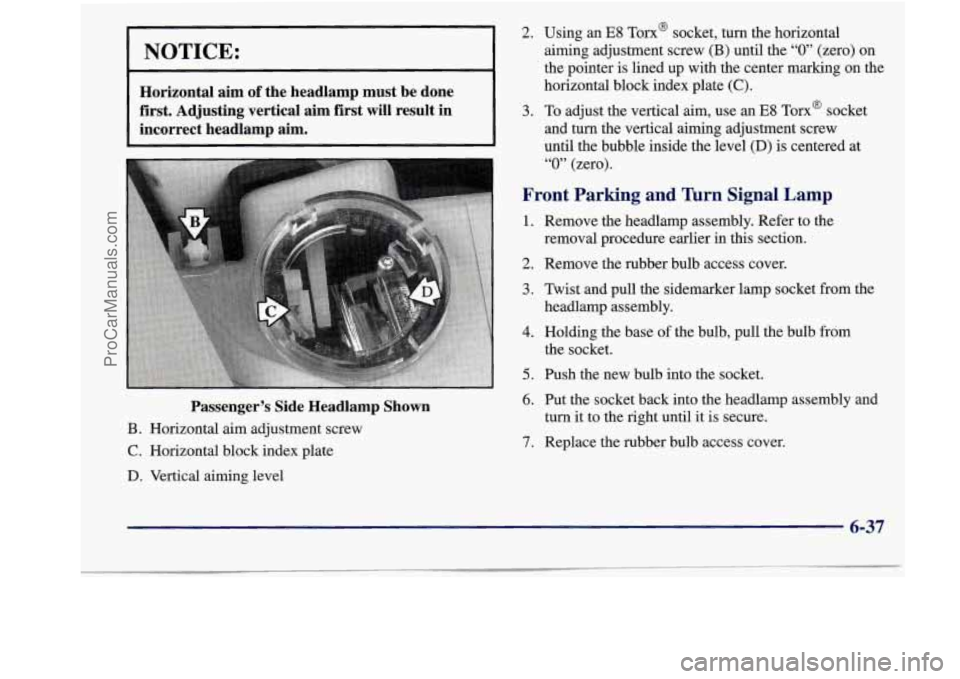
NOTICE:
Horizontal aim of the headlamp must be done
first. Adjusting vertical
aim first will result in
2. Using an E8 Torx@ socket, turn the horizontal
aiming adjustment screw
(B) until the “0” (zero) on
the pointer is lined up with the center marking on the
horizontal block index plate
(C).
3. To adjust the vertical aim, use an E8 Torn@ socket
and turn the vertical aiming adjustment screw
until the bubble inside the level
(D) is centered at
“0” (zero).
Front Parking and I’urn Signal Lamp
1. Remove the headlamp assembly. Refer to the
removal procedure earlier in this section.
2. Remove the rubber bulb access cover.
3. Twist and pull the sidemarker lamp socket from the
4. Holding the base of the bulb, pull the bulb from
5. Push the new bulb into the socket.
headlamp assembly.
the socket.
B.
C.
D.
Passenger’s Side Headlamp Shown
Horizontal aim adjustment screw Horizontal block index plate
Vertical aiming level
6. Put the socket back into the headlamp assembly and
turn it to the right until it is secure.
7. Replace the rubber bulb access cover.
6-37
ProCarManuals.com
Page 302 of 388
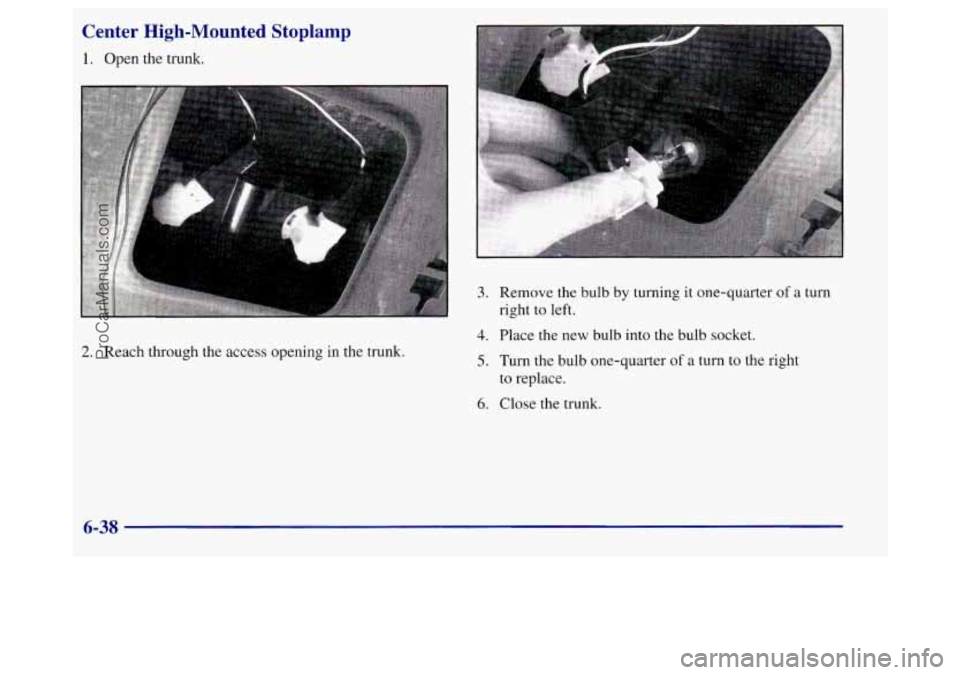
Center High-Mounted Stoplamp
1. Open the trunk.
2. Reach through the access opening in the trunk.
3. Remove the bulb by turning it one-quarter of a turn
right to left.
4. Place the new bulb into the bulb socket.
5. Turn the bulb one-quarter of a turn to the right
to replace.
6. Close the trunk.
6-38
ProCarManuals.com
Page 303 of 388
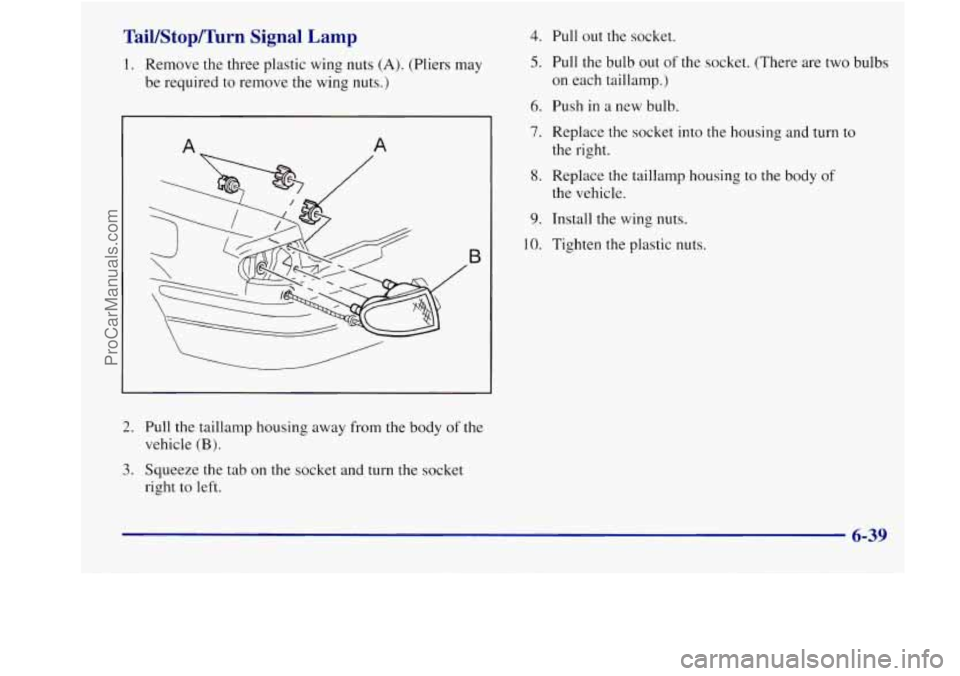
Tail/Stop/Turn Signal Lamp
1. Remove the three plastic wing nuts (A). (Pliers may
be required to remove the wing nuts.)
A A
B
2. Pull the taillamp housing away from the body of the
3. Squeeze the tab on the socket and turn the socket
vehicle
(B).
right to left.
4. Pull
out the socket.
5. Pull the bulb out of the socket. (There are two bulbs
on each taillamp.)
6. Push in a new bulb.
7. Replace the socket into the housing and turn to
the right.
8. Replace the taillamp housing to the body of
the vehicle.
9. Install the wing nuts.
10. Tighten the plastic nuts.
6-39
ProCarManuals.com
Page 304 of 388
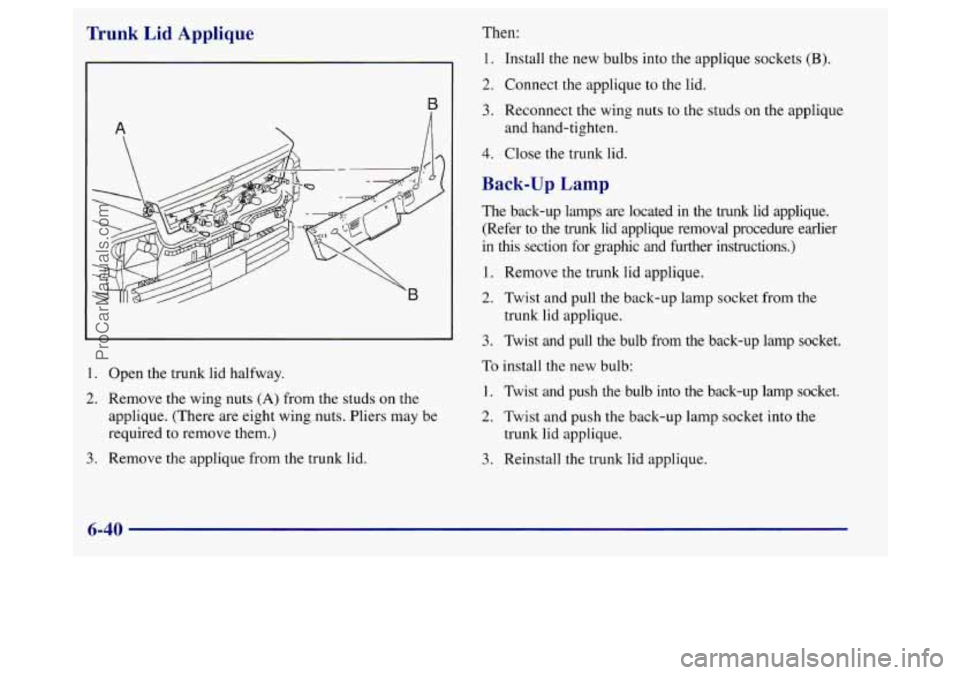
Trunk Lid Applique Then:
1. Install the new bulbs into the applique sockets (B).
A
1. Open the trunk lid halfway.
2. Remove the wing nuts (A) from the studs on the
applique. (There are eight wing nuts. Pliers may be
required to remove them.)
3. Remove the applique from the trunk lid.
2. Connect the applique to the lid.
3. Reconnect the wing nuts to the studs on the applique
and hand-tighten.
4. Close the trunk lid.
Back-up Lamp
The back-up lamps are located in the trunk lid applique.
(Refer to the trunk
lid applique removal procedure earlier
in this section for graphic and further instructions.)
1. Remove the trunk lid applique.
2. Twist and pull the back-up lamp socket from the
trunk lid applique.
3. Twist and pull the bulb from the back-up lamp socket.
To install the new bulb:
1. Twist and push the bulb into the back-up lamp socket.
2. Twist and push the back-up lamp socket into the
trunk lid applique.
3. Reinstall the trunk lid applique.
6-40
ProCarManuals.com
Page 305 of 388
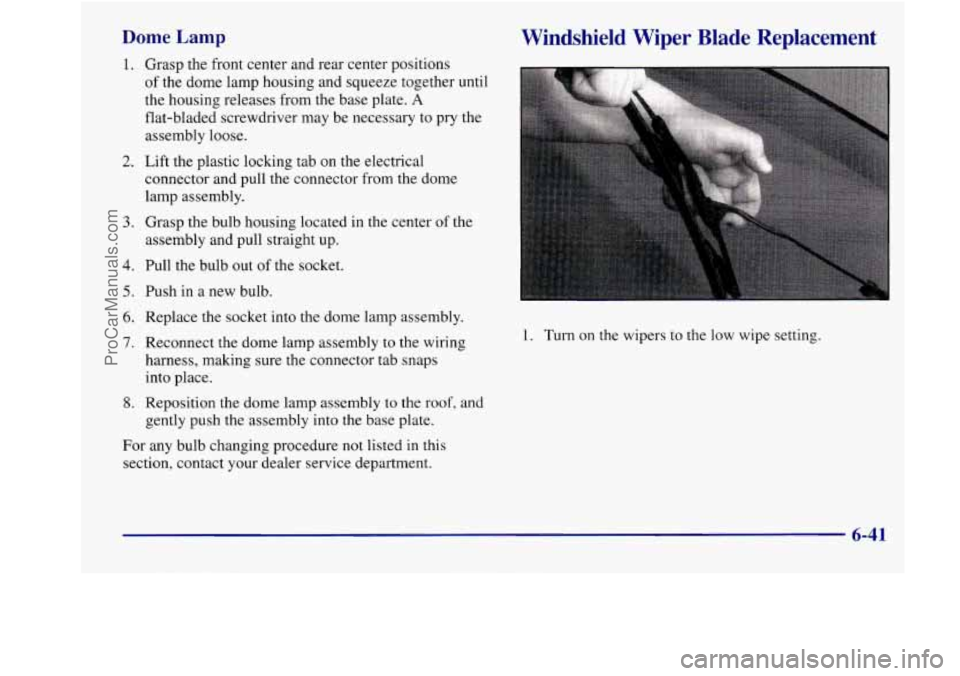
Dome Lamp
1.
2.
3.
4.
5.
6.
7.
8.
Grasp the front center and rear center positions
of the dome lamp housing and squeeze together until
the housing releases from the base plate.
A
flat-bladed screwdriver may be necessary to pry the
assembly loose.
Lift the plastic locking tab on the electrical
connector and pull the connector from the dome
lamp assembly.
Grasp the bulb housing located in the center
of the
assembly and pull straight up.
Pull the bulb out
of the socket.
Push in a new bulb.
Replace the socket into the dome lamp assembly.
Reconnect the dome lamp assembly to the wiring
harness, making sure the connector tab snaps
into place.
Reposition the dome lamp assembly
to the roof, and
gently push the assembly into the base plate. 1. Turn
on the wipers to the low wipe setting.
For any bulb changing procedure
not listed in this
section, contact your dealer service department.
Windshield Wiper Blade Replacement
6-41
ProCarManuals.com
Page 306 of 388
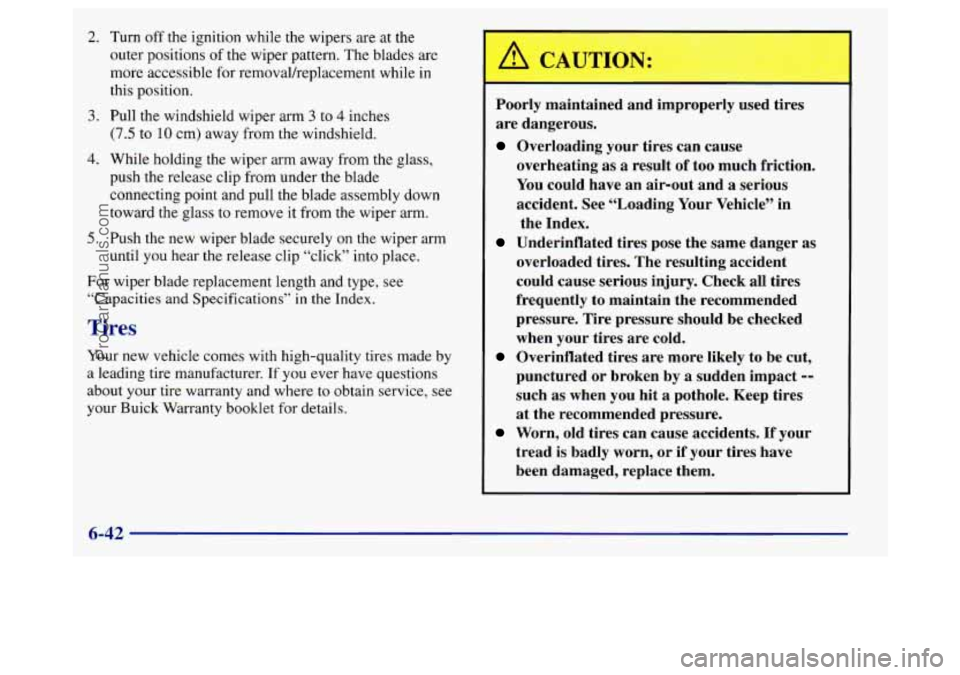
2. Turn off the ignition while the wipers are at the
outer positions of the wiper pattern. The blades are
more accessible for removalh-eplacement while in
this position.
3. Pull the windshield wiper arm 3 to 4 inches
(7.5 to 10 cm) away from the windshield.
4. While holding the wiper arm away from the glass,
push the release clip from under the blade
connecting point and pull the blade assembly down
toward the glass to remove it from the wiper arm.
5. Push the new wiper blade securely on the wiper arm
until
you hear the release clip “click” into place.
For wiper blade replacement length and type, see
“Capacities and Specifications”
in the Index.
Tires
Your new vehicle comes with high-quality tires made by
a leading tire manufacturer. If you ever have questions
about your tire warranty and where
to obtain service, see
your Buick Warranty booklet for details.
Poorly maintained and improperly used tires
are dangerous.
Overloading your tires can cause
overheating
as a result of too much friction.
You could have an air-out and
a serious
accident. See “Loading Your Vehicle” in
the Index.
Underinflated tires pose the same danger as
overloaded tires. The resulting accident
could cause serious injury. Check all tires
frequently to maintain the recommended
pressure. Tire pressure should be checked
when your tires are cold.
Overinflated tires are more likely to be cut,
punctured or broken by a sudden impact
--
such as when you hit a pothole. Keep tires
at the recommended pressure.
Worn, old tires can cause accidents. If your
tread
is badly worn, or if your tires have
been damaged, replace them.
6-42
ProCarManuals.com
Page 307 of 388
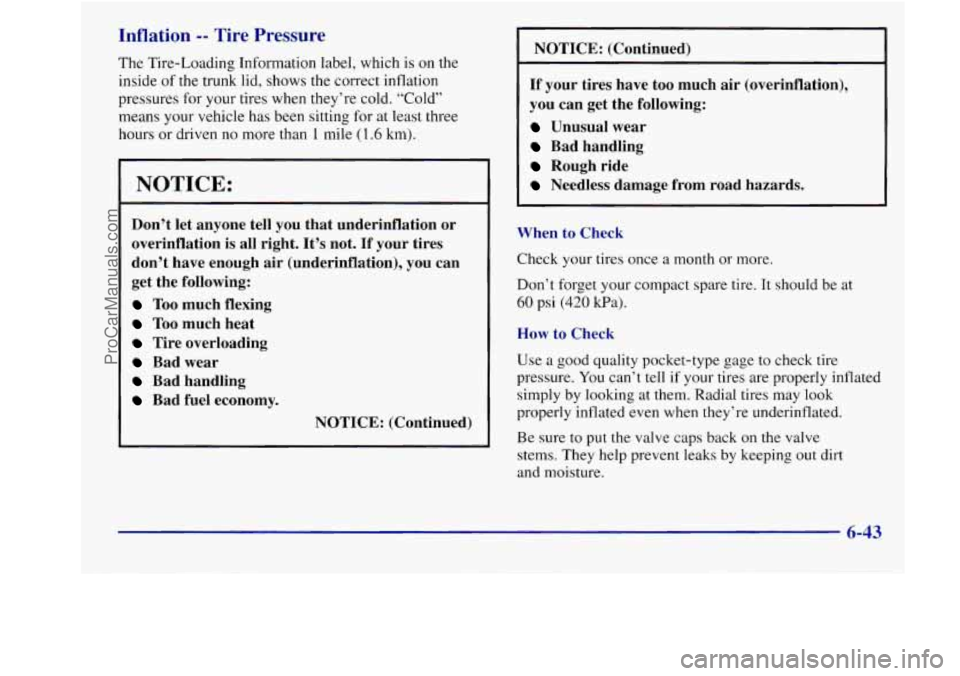
Inflation -- Tire Pressure
The Tire-Loading Information label, which is on the
inside
of the trunk lid, shows the correct inflation
pressures for your tires when they’re cold. “Cold”
means your vehicle has been sitting for at least three
hours or driven no more than
1 mile (1.6 km).
NOTICE:
Don’t let anyone tell you that underinflation or
overinflation is
all right. It’s not. If your tires
don’t have enough air (underinflation), you can
get the following:
Too much flexing
Too much heat
Tire overloading
Bad wear
Bad handling
Bad fuel economy.
NOTICE: (Continued) NOTICE:
(Continued)
If your tires have too much air (overinflation),
you can get the following:
Unusual wear
Bad handling
Rough ride
Needless damage from road hazards.
When to Check
Check your tires once a month or more.
Don’t forget your compact spare tire. It should be at
60 psi (420 kPa).
How to Check
Use a good quality pocket-type gage to check tire
pressure. You can’t tell
if your tires are properly inflated
simply by looking at them. Radial tires may look
properly inflated even when they’re underinflated.
Be sure to put the valve caps back on the valve
stems. They help prevent leaks by keeping out
dirt
and moisture.
6-43
ProCarManuals.com
Page 308 of 388
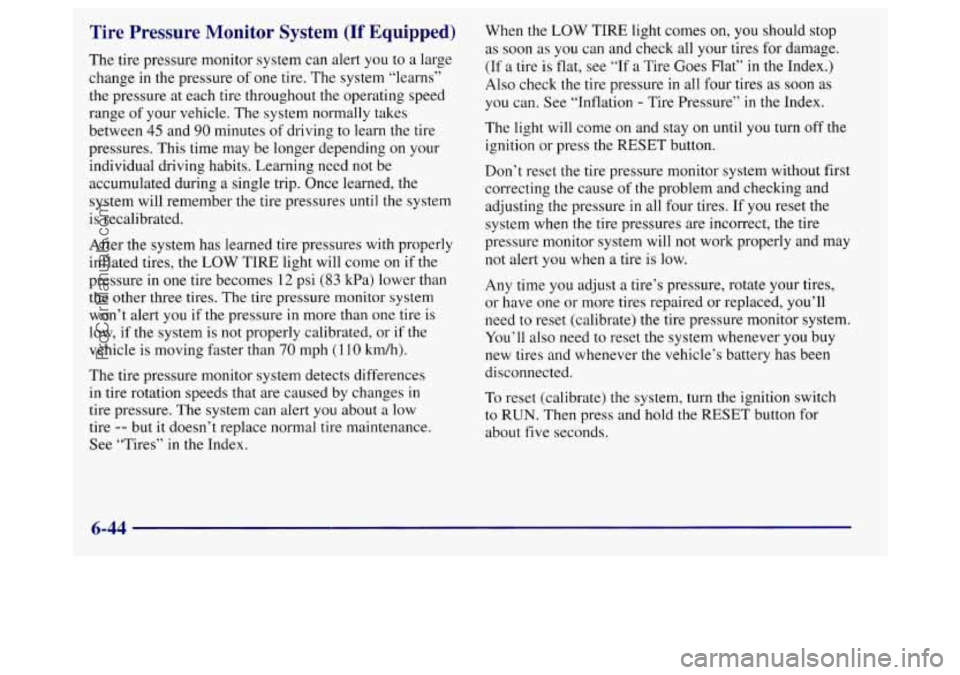
Tire Pressure Monitor System (If Equipped)
The tire pressure monitor system can alert you to a large
change in the pressure
of one tire. The system “learns”
the pressure at each tire throughout the operating speed
range of your vehicle. The system normally takes
between
45 and 90 minutes of driving to learn the tire
pressures. This time may be longer depending on your
individual driving habits. Learning need not be
accumulated during
a single trip. Once learned, the
system will remember the tire pressures until the system
is recalibrated.
After the system has learned tire pressures with properly
inflated tires, the LOW TIRE light will come on if the
pressure in
one tire becomes 12 psi (83 kPa) lower than
the other three tires. The tire pressure monitor system
won’t alert you if the pressure
in more than one tire is
low, if the system is not properly calibrated, or if the
vehicle
is moving faster than 70 mph (1 10 kdh).
The tire pressure monitor system detects differences
in tire rotation speeds that are caused by changes
in
tire pressure. The system can alert you about a low
tire
-- but it doesn’t replace normal tire maintenance.
See “Tires” in the Index. When the LOW
TIRE light comes
on, you should stop
as soon as you can and check all your tires for damage.
(If a tire is flat, see “If
a Tire Goes Flat” in the Index.)
Also check
the tire pressure in all four tires as soon as
you can. See “Inflation
- Tire Pressure” in the Index.
The light will come on and stay on
until you turn off the
ignition or press the
RESET button.
Don’t reset the tire pressure monitor system without first
correcting the cause of the problem and checking and
adjusting the pressure in all four tires. If you reset the
system when the tire pressures are incorrect, the tire
pressure monitor system will not work properly and may
not alert you when
a tire is low.
Any time
you adjust a tire’s pressure, rotate your tires,
or have one or more tires repaired or replaced, you’ll
need to reset (calibrate) the tire pressure monitor system.
You’ll also need to reset the system whenever you buy
new tires and whenever the vehicle’s battery has been
disconnected.
To reset (calibrate) the system,
turn the ignition switch
to
RUN. Then press and hold the RESET button for
about five seconds.
6-44
ProCarManuals.com
Page 309 of 388
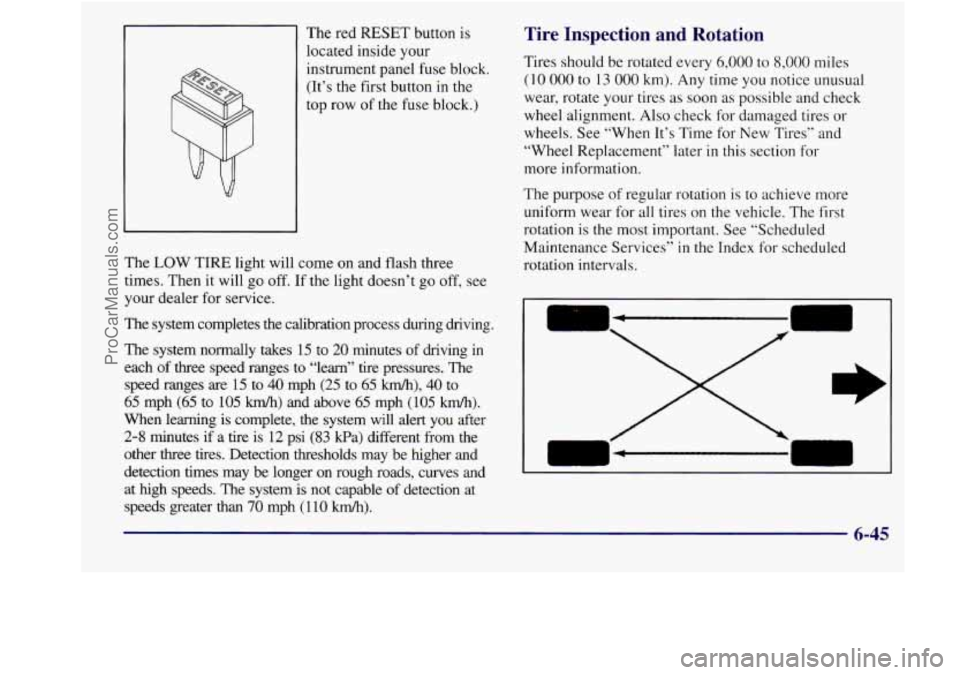
The red RESET button is
located inside your
instrument panel fuse block.
(It’s the first button in the
top row of the fuse block.)
The LOW TIRE light will come
on and flash three
times. Then it will go off. If the light doesn’t go off, see
your dealer for service.
The system completes the calibration process during driving.
The system normally takes
15 to 20 minutes of driving in
each of three speed ranges to “learn” tire pressures. The
speed ranges are 15 to 40 mph (25 to 65 km/h), 40 to
65 mph (65 to 105 km/h) and above 65 mph (105 km/h).
When learning is complete, the system will alert you after
2-8 minutes if a tire is 12 psi (83 kPa) different from the
other
three tires. Detection thresholds may be higher and
detection times may be longer on rough roads, curves and
at high speeds. The system
is not capable of detection at
speeds greater
than 70 mph (1 10 km/h).
Tire Inspection and Rotation
Tires should be rotated every 6,000 to 8,000 miles
(10 000 to 13 000 km). Any time you notice unusual
wear, rotate your tires
as soon as possible and check
wheel alignment. Also check for damaged tires or
wheels. See “When It’s Time for New Tires”
and
“Wheel Replacement” later in this section for
more information.
The purpose
of regular rotation is to achieve more
uniform wear for
all tires on the vehicle. The first
rotation is the most important. See “Scheduled
Maintenance Services”
in the Index for scheduled
rotation intervals.
6-45
ProCarManuals.com
Page 310 of 388
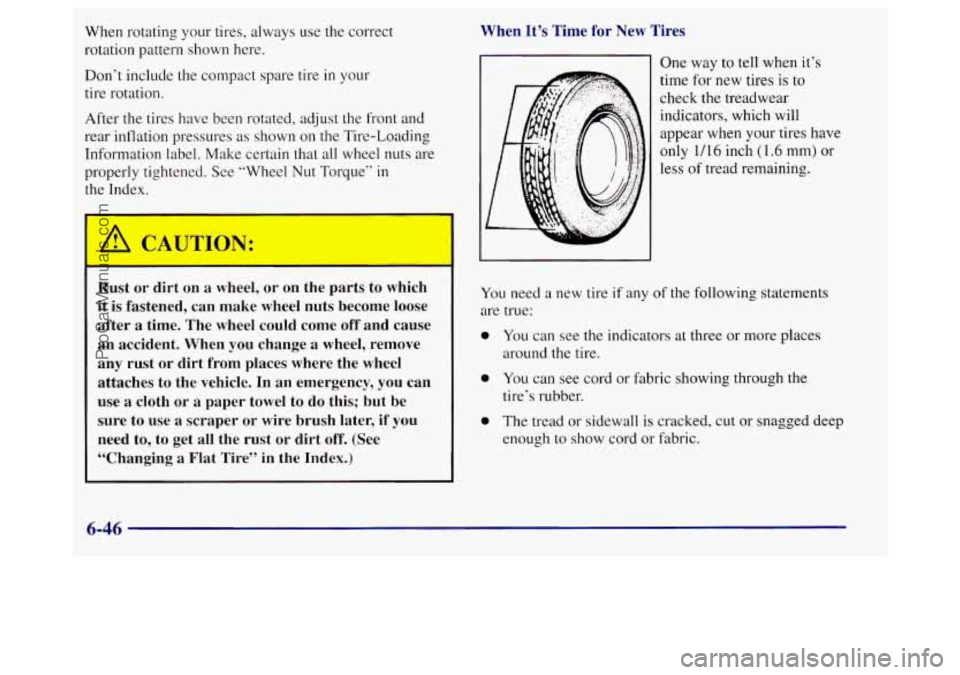
When rotating your tires, always use the correct
rotation pattern shown here.
Don’t include the compact spare tire in your
tire rotation.
After the tires have been rotated, adjust the front and
rear inflation pressures
as shown on the Tire-Loading
Information label. Make certain that all wheel nuts are
properly tightened. See “Wheel Nut Torque”
in
the Index.
Rust or dirt on a wheel, or on the parts to which
it is fastened, can make wheel nuts become loose
after
a time. The wheel could come off and cause
an accident. When
you change a wheel, remove
any rust or dirt from places where the wheel
attaches to the vehicle. In an emergency, you can
use a cloth or
a paper towel to do this; but be
sure to use a scraper or wire brush later,
if you
need to,
to get all the rust or dirt off. (See
“Changing a Flat, Tire” in the Index.)
When It’s Time for New Tires
11 One way to tell when it’s
time for new tires is to
check the treadwear
indicators, which will
appear when your tires have
only
1/16 inch (1.6 mm) or
less of tread remaining.
You need a new tire if any of the following statements
are true:
0 You can see the indicators at three or more places
around the tire.
0 You can see cord or fabric showing through the
tire’s rubber.
0 The tread or sidewall is cracked, cut or snagged deep
enough to show cord or fabric.
6-46
ProCarManuals.com